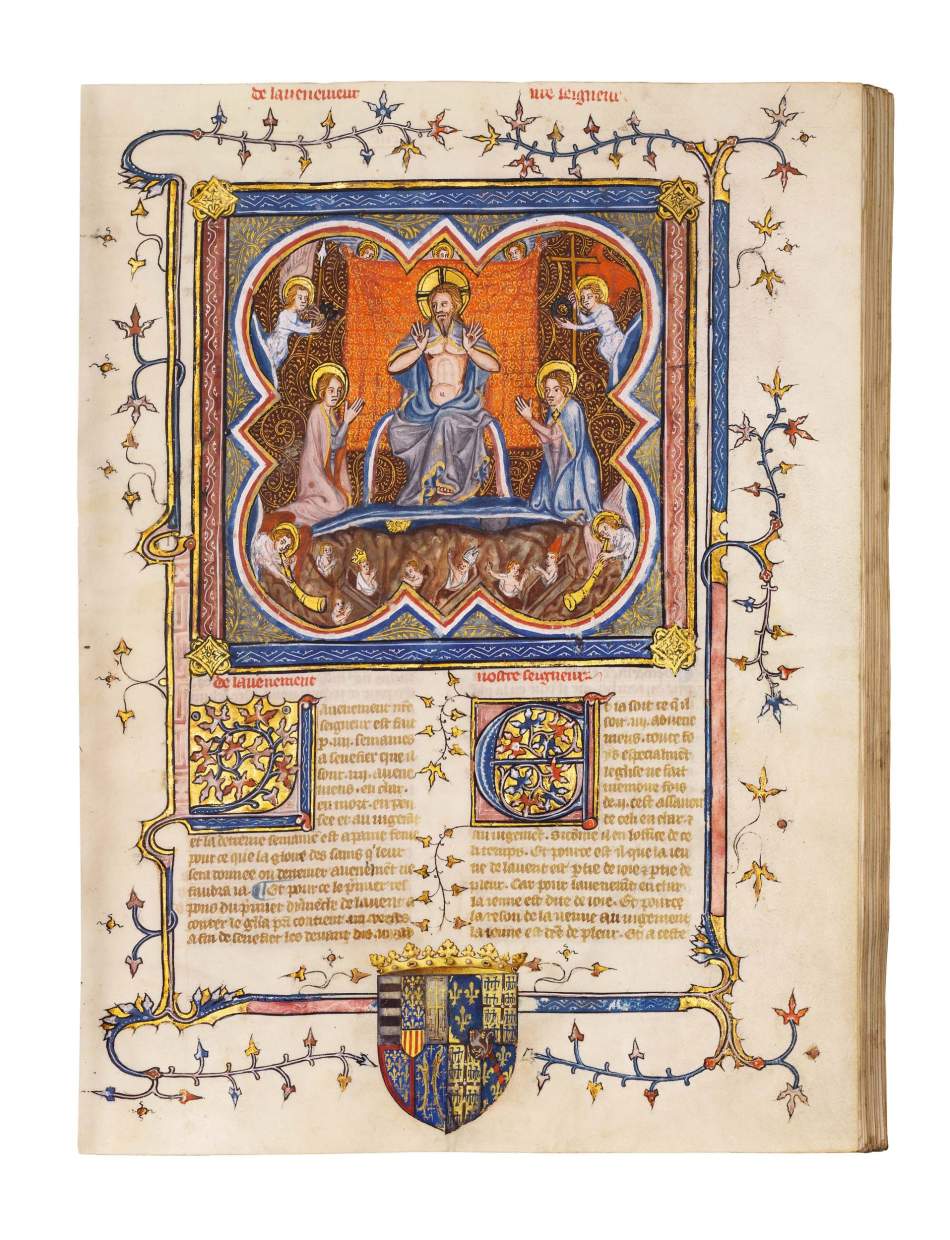

Jacobus de Voragine, Legende Dorée. Translated to French by Jean de Vignay. Manuscript illuminated in the circle of the Master of the Jean de Sy Bible. France, Paris, c. 1375.
312 x 228 mm, 270 leaves, vellum. With 1 large miniature with full border, 87 historiated initials with three-quarter borders.
Provenance: Library of René d’Anjou and Jeanne de Laval (d. 1498); Laval, Chapter of St. Tugal; Louis de Gand, Comte de Merode, Prince d’Isenghien etc. (d. 1767).


Jacobus de Voragine, Legende Dorée. Translated to French by Jean de Vignay. Manuscript illuminated in the circle of the Master of the Jean de Sy Bible. France, Paris, c. 1375.
312 x 228 mm, 270 leaves, vellum. With 1 large miniature with full border, 87 historiated initials with three-quarter borders.
Provenance: Library of René d’Anjou and Jeanne de Laval (d. 1498); Laval, Chapter of St. Tugal; Louis de Gand, Comte de Merode, Prince d’Isenghien etc. (d. 1767).
Hide caption

Jacobus de Voragine, Legende Dorée. Translated to French by Jean de Vignay. Manuscript illuminated in the circle of the Master of the Jean de Sy Bible. France, Paris, c. 1375.
312 x 228 mm, 270 leaves, vellum. With 1 large miniature with full border, 87 historiated initials with three-quarter borders.
Provenance: Library of René d’Anjou and Jeanne de Laval (d. 1498); Laval, Chapter of St. Tugal; Louis de Gand, Comte de Merode, Prince d’Isenghien etc. (d. 1767).
Hide caption

Jacobus de Voragine, Legende Dorée. Translated to French by Jean de Vignay. Manuscript illuminated in the circle of the Master of the Jean de Sy Bible. France, Paris, c. 1375.
312 x 228 mm, 270 leaves, vellum. With 1 large miniature with full border, 87 historiated initials with three-quarter borders.
Provenance: Library of René d’Anjou and Jeanne de Laval (d. 1498); Laval, Chapter of St. Tugal; Louis de Gand, Comte de Merode, Prince d’Isenghien etc. (d. 1767).
Hide caption

Jacobus de Voragine, Legende Dorée. Translated to French by Jean de Vignay. Manuscript illuminated in the circle of the Master of the Jean de Sy Bible. France, Paris, c. 1375.
312 x 228 mm, 270 leaves, vellum. With 1 large miniature with full border, 87 historiated initials with three-quarter borders.
Provenance: Library of René d’Anjou and Jeanne de Laval (d. 1498); Laval, Chapter of St. Tugal; Louis de Gand, Comte de Merode, Prince d’Isenghien etc. (d. 1767).
Hide caption

Jacobus de Voragine, Legende Dorée. Translated to French by Jean de Vignay. Manuscript illuminated in the circle of the Master of the Jean de Sy Bible. France, Paris, c. 1375.
312 x 228 mm, 270 leaves, vellum. With 1 large miniature with full border, 87 historiated initials with three-quarter borders.
Provenance: Library of René d’Anjou and Jeanne de Laval (d. 1498); Laval, Chapter of St. Tugal; Louis de Gand, Comte de Merode, Prince d’Isenghien etc. (d. 1767).
Hide caption

Jacobus de Voragine, Legende Dorée. Translated to French by Jean de Vignay. Manuscript illuminated in the circle of the Master of the Jean de Sy Bible. France, Paris, c. 1375.
312 x 228 mm, 270 leaves, vellum. With 1 large miniature with full border, 87 historiated initials with three-quarter borders.
Provenance: Library of René d’Anjou and Jeanne de Laval (d. 1498); Laval, Chapter of St. Tugal; Louis de Gand, Comte de Merode, Prince d’Isenghien etc. (d. 1767).
Hide caption

Jacobus de Voragine, Legende Dorée. Translated to French by Jean de Vignay. Manuscript illuminated in the circle of the Master of the Jean de Sy Bible. France, Paris, c. 1375.
312 x 228 mm, 270 leaves, vellum. With 1 large miniature with full border, 87 historiated initials with three-quarter borders.
Provenance: Library of René d’Anjou and Jeanne de Laval (d. 1498); Laval, Chapter of St. Tugal; Louis de Gand, Comte de Merode, Prince d’Isenghien etc. (d. 1767).
Hide caption
Almost ninety charming miniatures, well-chosen and self-explanatory, illustrate the individual texts. The manuscript opens with an imposing miniature of the Last Judgement with Christ seated in heaven, embodying the artistic style and mastercraft of the influential Boqueteaux workshop. The image is set within a quatrefoil positioned in a large painted square frame, in rich colours and burnished gold. Around ten codices of the Legende Dorée survive that were illuminated in this most prolific shop in Paris, active during the reign of Charles V (1364-1380), which demonstrates how highly specialised these artists were.
The Golden Legend, or Legenda Aurea, is one of the classic works of the Middle Ages, containing lively tales of saints' miracles written in an accessible style to address a wide audience. Hardly any text has been more popular and its text tradition, therefore, offers quite interesting variants all over Europe. These stories show the persistence and determination of many saints, almost all of which are illustrated in an eye-catching, lively way. Such books were at the heart of the education of the young nobility, boys as well as girls.
This luxurious manuscript was handed down in the Anjou family until René d’Anjou, the second son of Louis II d’Anjou, received it by inheritance. As Duke of Anjou and Count of Provence (1434-1480), King of Naples, and titular King of Jerusalem and Aragon (including Sicily, Majorca and Corsica), he amassed a famous library in his castle at Angers, but never added an ex-libris or any provenance inscriptions to his books. It was his widow, Jeanne de Laval who added their joint coat of arms on the openings page, before she passed the book on to the daughters of her family. This luxurious copy of the Legend Dorée is the only one still in private hands.
Read more about this manuscript in our Spotlight on Paris, and in our Spotlight on Royal Codices.



